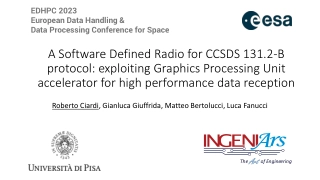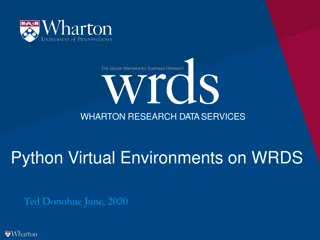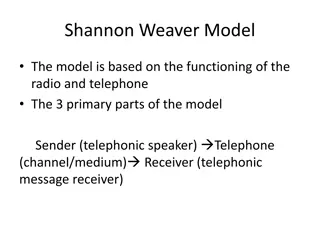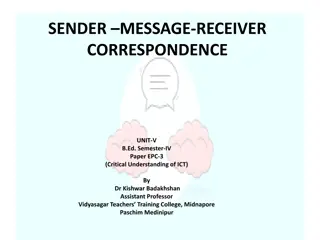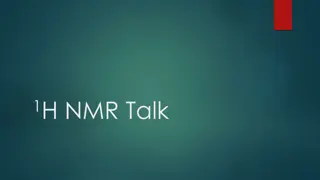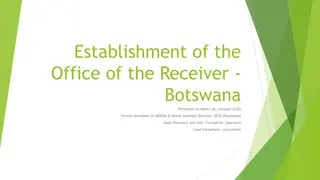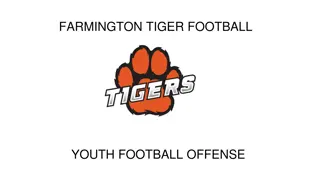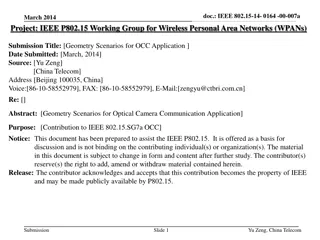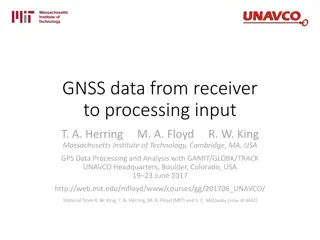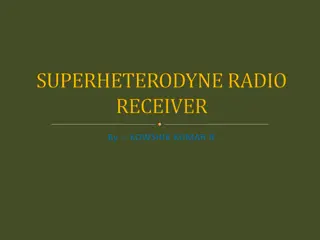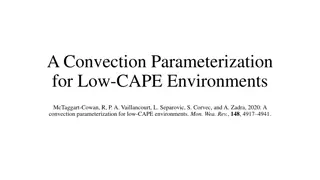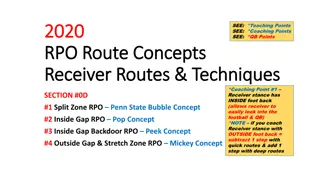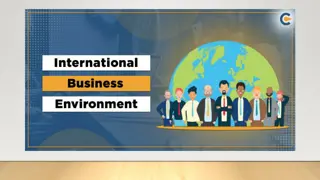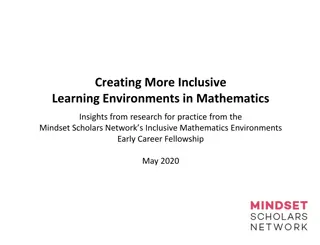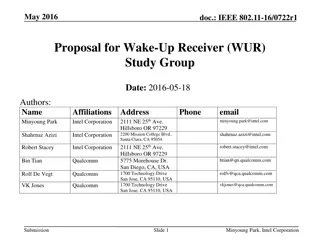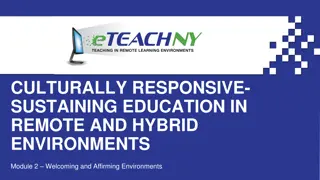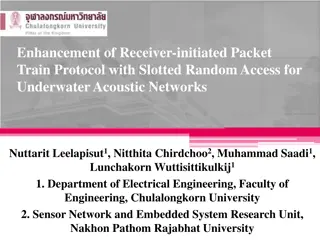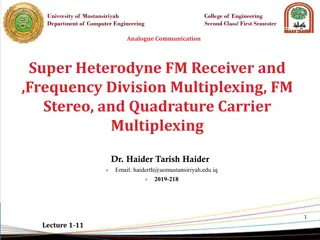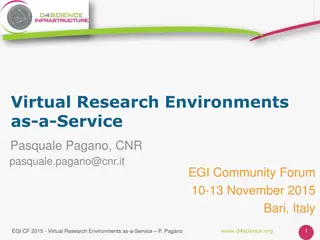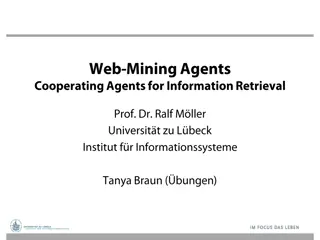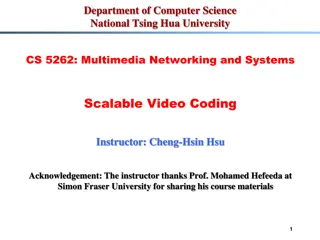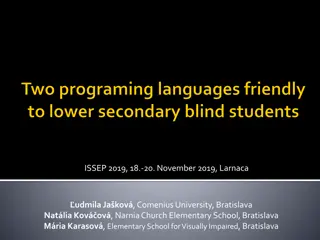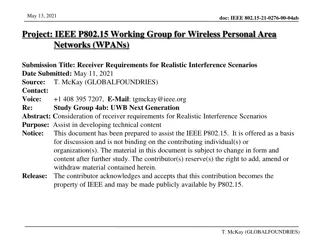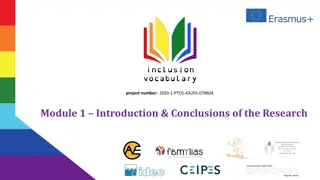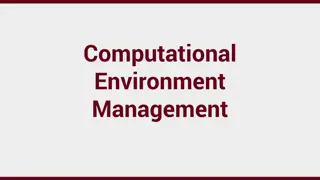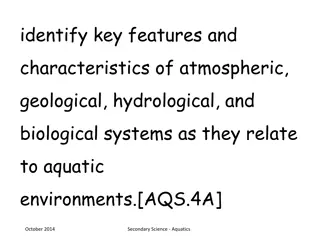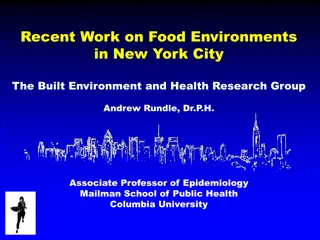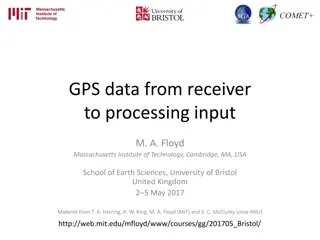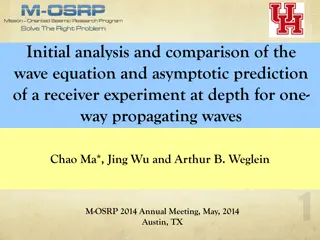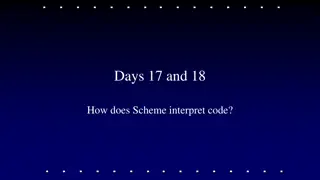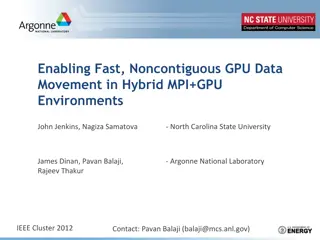Rescue Drone: Increasing Autonomy and Implementing Computer Vision
Focuses on developing a rescue drone with increased autonomy and implementing computer vision for advanced object detection. The team, consisting of Cody Campbell (Hardware Engineer), Alexandra Borgesen (Computer Engineer), Halil Yonter (Team Leader), Shawn Cho (Software Engineer), Peter Burchell (M
78 views • 44 slides
Dominate Your Career Ace L3M1 Procurement & Supply Environments Exam with Confidence
Achieve success in the L3M1 Procurement and Supply Environments exam with confidence. Prepare effectively with comprehensive study materials and practice tests. Gain expertise in procurement processes, supply chain management, and industry environments. Validate your skills and enhance your career p
1 views • 4 slides
Enhancing Data Reception Performance with GPU Acceleration in CCSDS 131.2-B Protocol
Explore the utilization of Graphics Processing Unit (GPU) accelerators for high-performance data reception in a Software Defined Radio (SDR) system following the CCSDS 131.2-B protocol. The research, presented at the EDHPC 2023 Conference, focuses on implementing a state-of-the-art GP-GPU receiver t
0 views • 33 slides
Environments,Tuples,& Dictionaries
Explore the concepts of environments, tuples, and dictionaries in Python through visual diagrams and explanations. Learn about how Python interprets programs, assignments, functions, and function calls within different frames and environments. Discover the rules for name lookup in user-defined funct
2 views • 27 slides
Managing Python Virtual Environments on WRDS
Understanding and creating virtual environments on WHARTON RESEARCH DATA SERVICES (WRDS) allows users to isolate Python packages for different projects, ensuring compatibility and preventing conflicts. This guide covers creating, activating, deactivating, and using pip to install Python packages wit
0 views • 13 slides
Communication Models Overview
The Shannon-Weaver Model is based on the functioning of radio and telephone, with key parts being sender, channel, and receiver. It involves steps like information source, transmitter, channel, receiver, and destination. The model faces technical, semantic, and effectiveness problems. The Linear Mod
0 views • 8 slides
Understanding Media Ecology: Impact of Communication Technology
Media ecology is a theoretical concept analyzing the influence of media and communication technology on human culture. Neil Postman, a prominent figure in the field, delves into how communication media affect human perception, understanding, and values. This study views media as environments shaping
4 views • 23 slides
Understanding Sender, Message, Receiver Correspondence in Communication Process
Communication process involves sender, message, and receiver elements. The sender initiates communication, generates a message, and conveys it to the receiver. The message is encoded, transmitted through a channel, and decoded by the receiver. Noise can hinder the communication process by interferin
1 views • 13 slides
Understanding 1H NMR and Proton Environments in Molecules
Exploring the concept of proton environments in molecules using 1H NMR spectroscopy. The presence of different types of hydrogens in a molecule is highlighted, showcasing how protons exist in varied magnetic environments leading to distinct signals in the 1H NMR spectrum. Electron shielding and its
0 views • 36 slides
Establishment of the Office of the Receiver in Botswana
The Office of the Receiver, established under the Proceeds and Instruments of Crime Act of 2014 in Botswana, appoints a Receiver responsible for preserving the value of property under its possession. The Receiver has broad powers including managing property, realizing investments, and even selling v
0 views • 7 slides
Farmington Tiger Football Youth Offensive Formations and Concepts
In the Farmington Tiger Football youth program, coordinated offensive formations and concepts are emphasized for players in grades 3-12. The program aims to maintain consistency in offensive strategies while allowing some flexibility for coaches to incorporate age-appropriate concepts. Various forma
0 views • 54 slides
Understanding Receivers and Noise in Radio Astronomy
Discover the challenges faced in radio astronomy due to noise, with the signal often indistinguishable from background noise. Learn about receiver sensitivity issues, minimizing thermal noise, and mitigating atmospheric effects to improve observation quality. Explore the essential elements of telesc
0 views • 55 slides
Geometry Scenarios for Optical Camera Communication Application
This document, submitted by Yu Zeng from China Telecom to IEEE 802.15 Working Group, focuses on geometry scenarios for Optical Camera Communication (OCC) applications. It includes simulations for indoor office and hall environments, detailing room dimensions, transmitter and receiver locations, and
0 views • 6 slides
Effective Communication Strategies in Business Environments
Explore the various aspects of communication processes within organizations, including sender-receiver dynamics, communication channels, small group networks, upward and downward communication methods, business communication tools, information richness of channels, email and voice mail etiquette, an
0 views • 21 slides
Understanding GNSS Data Processing with RINEX Formats
Explore the journey of GNSS data from receiver to processing input, focusing on the motivation behind the Receiver INdependent EXchange (RINEX) format and the evolution from RINEX 2 to RINEX 3. Learn about raw data formats, RINEX file conventions, and the significance of RINEX 2 data format in GPS o
1 views • 15 slides
Introduction to Superheterodyne Radio Receiver Circuits
Superheterodyne radio receiver circuits operate based on heterodyne or frequency mixing principles. These circuits involve using a local oscillator to mix the incoming signal with a sine wave, shifting it to an intermediate frequency (IF) for further processing and demodulation. The design includes
0 views • 16 slides
Convection Parameterization for Low-CAPE Environments
Many global Numerical Weather Prediction systems face challenges predicting convective activity in low-CAPE environments. This study introduces a convection parameterization scheme based on moisture convergence to better represent convective effects. The scheme focuses on the triggering function, up
1 views • 38 slides
Football RPO Route Concepts and Coaching Points
This detailed guide covers teaching and coaching points for football RPO (Run-Pass Option) route concepts, receiver stances, techniques, and play signals. It emphasizes proper receiver stance, route concepts like Split Zone, Bubble Concept, Pop Concept, and more. The content provides insights on rec
0 views • 7 slides
Understanding Factors of Change in Business Environments
Factors of change in business environments encompass socio-cultural, economic, technological, political, and legal elements. These factors influence how businesses operate and make decisions in a dynamic world. The social environment, cultural environment, and economic environment play crucial roles
0 views • 8 slides
Enhancing Inclusivity in Mathematics Learning Environments
Mindset Scholars Network's Inclusive Mathematics Environments Fellowship aims to create inclusive math spaces for marginalized students. Insights from research emphasize the importance of fostering belonging and identity development in education, especially in the face of COVID-19 disruptions. By ch
0 views • 34 slides
Proposal for Wake-Up Receiver (WUR) Study Group in IEEE 802.11-16
The document presents a proposal for the creation of a Wake-Up Receiver (WUR) Study Group within the IEEE 802.11-16 standard. The WUR technology aims to enable energy-efficient data reception without increasing latency, with a defined scope of work and feasibility. The proposal outlines the need for
0 views • 14 slides
Creating Welcoming Environments in Remote and Hybrid Education
This module explores the importance of creating welcoming and affirming environments in remote and hybrid educational settings. Through immersive scenarios, it prompts reflection on the impact of initial interactions on individuals entering a new space. Emphasis is placed on fostering a sense of bel
0 views • 34 slides
Enhancing Receiver-Initiated Packet Train Protocol for Underwater Acoustic Networks
This study focuses on enhancing the Receiver-Initiated Packet Train Protocol with Slotted Random Access for Underwater Acoustic Networks. The research explores the challenges of underwater communication, the characteristics of underwater sensor networks, and the RIPT protocol along with its improvem
0 views • 17 slides
Analogue Communication Techniques in Super Heterodyne FM Receiver
Explore the intricacies of analogue communication in the context of a Super Heterodyne FM Receiver. Delve into topics such as Frequency Division Multiplexing, FM Stereo, and Quadrature Carrier Multiplexing as presented by Dr. Haider Tarish Haider from University of Mustansiriyah. Access lecture slid
0 views • 16 slides
Virtual Research Environments as-a-Service: Advancing Collaborative Research Efforts
Explore how Virtual Research Environments as-a-Service, exemplified by D4Science, enhance research collaboration by providing operational ecosystems, genealogy testbeds, and e-Infrastructures. These environments cater to diverse user needs, from data management to cost reduction, offering capabiliti
0 views • 27 slides
Exploring Virtual Environments in Computing: An Overview
Virtual environments in computing encompass a range of technologies, from virtual memory to virtual machines and virtual execution environments. These environments allow software to run in a different setting than originally designed, minimizing complexities. Key components include virtual memory, m
0 views • 26 slides
Exploring Chess Strategies and Environments in AI
Dive into the world of chess AI with a focus on different strategies and environments such as playing with a clock, deterministic scenarios, and more. Explore the nuances of fully observable, episodic, and discrete environments in AI chess applications.
0 views • 38 slides
Understanding Stream Adaptation Methods in Multimedia Networking
The course covers various stream adaptation methods for multimedia networking, including transcoding, simulcasting, Multi-Description Coding (MDC), and Scalable Video Coding (SVC). These methods address the challenges of heterogeneous receiver environments and dynamic network conditions. Each approa
0 views • 40 slides
Enhancing Programming Skills for Blind Students with Alan and Torino Environments
In this research study, blind students' misconceptions in solving tasks with command sequences and loops are observed. The study explores the use of Alan and Torino programming environments for blind students. The research aims to understand the advantages and disadvantages of programming in these e
0 views • 16 slides
Receiver Requirements for Realistic Interference Scenarios in Wireless Personal Area Networks
This document discusses the receiver requirements for handling realistic interference scenarios in Wireless Personal Area Networks (WPANs). It covers topics such as second-order distortion, direct conversion receivers, blocker mitigation techniques, and proposals to specify sensitivity levels in the
0 views • 6 slides
Creating Inclusive Environments in Schools for LGBTQI+ Community
Creating a new Inclusion Vocabulary to promote acceptance of sexual orientation among teachers and students in high schools. Financed by the Erasmus+ Programme, this project aims to provide digital resources, training, and sensitivity for educators to foster inclusive environments. The project focus
0 views • 21 slides
Managing Software Environments for Reproducibility
Efficient management of computational environments is crucial to ensure software reproducibility. Learn how to record software environments, use tools like Miniconda and pip for package installation, and manage R packages for reproducible research.
0 views • 17 slides
Exploring Avatar Path Clustering in Networked Virtual Environments
Explore the concept of Avatar Path Clustering in Networked Virtual Environments where users with similar behaviors lead to comparable avatar paths. This study aims to group similar paths and identify representative paths, essential in analyzing user interactions in virtual worlds. Discover related w
0 views • 31 slides
Understanding Aquatic Environments: Systems and Interactions
Explore the key features and characteristics of atmospheric, geological, hydrological, and biological systems in relation to aquatic environments. Apply systems thinking to analyze positive and negative feedback cycles. Utilize technology to collect and evaluate global environmental data. Evaluate d
0 views • 28 slides
Four Channel Ultrasonic Receiver Project Overview
Design and create a Four Channel Ultrasonic Receiver capable of receiving signals between 30 kHz and 50 kHz, including chirp and constant frequency signals. The project involves detailed system design, testing, circuit design, PCB layout, and various project milestones. High risks such as component
0 views • 12 slides
Recent Research on Food Environments in New York City
Exploring the impact of food environments on BMI among respondents to the NYC Community Health Survey, this research delves into neighborhood effects on diet, physical activity, and BMI. Analyses adjust for various factors, and the association between BMI and BMI-unhealthy outlets is examined in rel
0 views • 7 slides
Understanding GPS Data Processing from Receiver to RINEX Format
Explore the journey of GPS data from receiver input to RINEX format, bridging the gap between various manufacturer-specific file formats. Learn about the motivation behind the Receiver INdependent EXchange (RINEX) format and how it enables universal exchange of raw GPS data. Delve into RINEX formats
0 views • 13 slides
Analysis and Comparison of Wave Equation Prediction for Propagating Waves
Initial analysis and comparison of the wave equation and asymptotic prediction of a receiver experiment at depth for one-way propagating waves. The study examines the amplitude and information derived from a wave equation migration algorithm and its asymptotic form. The focus is on the prediction of
0 views • 23 slides
Understanding Scheme's Execution Mechanism: Syntax, Semantics, and Environments
Dive into Scheme's interpretation of code, from representing syntax and semantics to implementing lexical scoping with first-class procedures. Explore the concept of variable bindings, environments, local environments, and procedures (closures) in Scheme's execution mechanism.
0 views • 22 slides
Fast Noncontiguous GPU Data Movement in Hybrid MPI+GPU Environments
This research focuses on enabling efficient and fast noncontiguous data movement between GPUs in hybrid MPI+GPU environments. The study explores techniques such as MPI-derived data types to facilitate noncontiguous message passing and improve communication performance in GPU-accelerated systems. By
0 views • 18 slides


